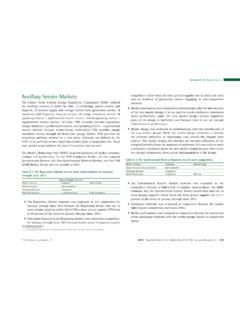Transcription of Best Practices of Emergency Shelters
1 Cynthia Nagendra Kay Moshier McDivitt best Practices of Emergency Shelters : The Critical Role of Emergency Shelter in an Effective Crisis response System The National Alliance to End Homelessness is the leading national voice on the issue of homelessness. The Alliance analyzes policy and develops pragmatic, effective policy solutions. The Alliance works collaboratively with the public, private, and nonprofit sectors to build state and local capacity, leading to stronger programs and policies that help communities achieve their goal of ending homelessness. The Alliance provides data and research to policymakers and elected officials in order to inform policy debates and edu- cate the public and opinion leaders nationwide.
2 !Working with a strong network of innovators, the National Alliance to End Homelessness identifies and evaluates hundreds of policy and program strategies and their impact on homelessness. The Alliance s Center for Capacity Building helps communities replicate and customize the best of those strategies. The Center focuses on strategies that are cost effective, data driven, and can be implemented at a scale that can significantly reduce homelessness.!Who is here? q Executive Directors/Program Directors q Case Managers q Rapid Re-housing Providers q Transitional Housing, Permanent Supportive Housing, Services Provider q Other stakeholders Today s Training q The role of Emergency shelter in an effective crisis response system q Key components of an effective Emergency shelter that quickly ends homelessness q Shift current philosophy, practice.
3 And operations Key Components of Emergency Shelters in an Effective Crisis response System Housing First Approach Immediate and Easy Access Housing-focused Services Rapid Exits to Permanent Housing Using Data To Be Better MAKING THE PHILOSOPHICAL SHIFT Philosophical Shift Practice Shift Operations Shift Activity Please complete the following sentences: 1. I believe that the role of Emergency shelter in a crisis response system is 2. When any household enters shelter, the goal is to assist them Homelessness in Connecticut Homelessness in Connecticut 4038 people were homeless in Jan 2015 Overall homelessness has decreased 10% since 2013 People living in Shelters is down 4 percent from 2014 People living in Shelters is down 32 percent from 2013 Homelessness in Connecticut Chronic homelessness has decreased 21% Connecticut functionally ended chronic homelessness among veterans Shelters (From AHAR 2014)
4 1,488,465 people used homeless Shelters percent increase from 2013 percent decrease from 2007 Shelter Demographics 2014 Men, Women, Gender in Shelter Men, Women, Gender in US Shelter Demographics 2014 Under 18, 18-30, 31-50, 51-60, 17% 62 and Over, Age in Shelter Under 18, 18-30, 31-50, 51-60, 62 and Over, Age in US Shelter Demographics 2014 1 Person, 2 or More People, Household Size in Shelter 1 Person, 2 or More People, Household Size in US Shelter Demographics 2014 Adults with disabilities were four times more likely to be in shelter than adults without disabilities Living Situation Before Shelter Already Homeless, Housing, Institution, Other, Before Entering Shelter Living Situation Before Shelter Sheltered, Unsheltered, Before Entering Shelter -Homeless Situation Staying with Family, Staying with Friends, Rented unit, Owned, PSH, Before Entering Shelter - Housed Situation Length of Stay in 2014 0 50,000 100,000 150,000 200,000 250,000 300.
5 000 350,000 400,000 450,000 500,000 7 Days or Less 8 - 30 Days 31 - 180 Days 181 - 360 Days 361 - 365 Days Nunber of People Length of Stay in Emergency Shelter Key Elements of an Effective Crisis response System that Ends Homelessness An effective Crisis response System provides immediate and easy access to safe and decent shelter to anyone that needs it and aims to re-house people as quickly as possible Low-barrier shelter is a cornerstone of a functional crisis response system. Key Elements of an Effective Crisis response System that Ends Homelessness 1.
6 Access and Prioritization 2. Crisis and Interim Housing 3. Assistance to Return to Housing Key Elements of an Effective Crisis response System that Ends Homelessness Access and Prioritization Outreach Coordinated Entry Diversion Crisis and Interim Housing Immediate and easily accessible available for anyone Assistance to Return to Housing RRH PSH Mainstream public housing Key Elements of an Effective Crisis response System that Ends Homelessness The community provides low-barrier shelter immediately to any person experiencing unsheltered homelessness who wants it Some form of
7 Shelter (ES, TH, other temporary setting) is offered immediately ( , same day) The community ensures shelter is not contingent on sobriety, minimum income requirements, criminal records, or other unnecessary conditions Housing crisis resolution Rapid re-housing Permanent Supportive housing Market rate housing Voucher CRISIS response SYSTEM How Can I Help You? How Can I Help You Get Housed? - Iain De Jong, How To Be An Awesome Shelter Targets all families in shelter or living on the streets Served 1,615 families 2009 2014 Everyone received RRH assistance Average time in rapid re-housing is 110 days Average amount spent per family is $5,284 (includes financial assistance and all overhead costs) $4,137 of direct financial assistance LOS in shelter reduced from 71 days to 41 days As of 2013, 87% of families never returned to shelter National Alliance to End Homelessness 27 Community Example.
8 Salt Lake City, UT Before we tried to change people, now we support change in people. Staff Member, the Road Home, Salt Lake City, UT Key Component Housing First Approach: A Philosophical Shift Activity Are We a Housing First Community? 1. Complete the survey (adapted from USICH tool) 2. Find others from your community. Take 5 minutes to talk about your similarities/differences. 3. Next, identify two things that are a challenge to becoming a housing first community. What Does Housing First Mean? Housing First is a philosophy shift from the traditional housing ready approach Everyone is ready for housing, regardless of the complexity or severity of their needs.
9 Housing First is not a program , it is a system-wide orientation and response Ann Oliva SNAPS Weekly Focus National Alliance to End Homelessness Housing First Principles Homelessness is foremost a housing problem and should be treated as such Permanent housing is a right to which all are entitled People should be returned to or stabilized in permanent housing as quickly as possible and connected to resources necessary to sustain that housing Issues that may have contributed to a household s homelessness can best be addressed once they are permanently housed National Alliance to
10 End Homelessness Housing First Core Components Few to no programmatic prerequisites to permanent housing entry Low-barrier admission policies Rapid and streamlined entry into permanent housing Supportive services are voluntary National Alliance to End Homelessness Homelessness and Substance Abuse in CT 243,000 83,000 People in CT dependent on or abused alcohol within the previous year People in CT dependent on or abused illicit drugs within the previous year Alcohol and Drug Abuse in CT 4,047 410 Total homeless persons Chronic Substance Abuse 2015 CT PIT Count Activity: Create a Timeline to Housing 1.







